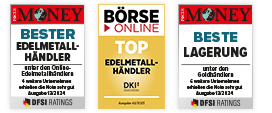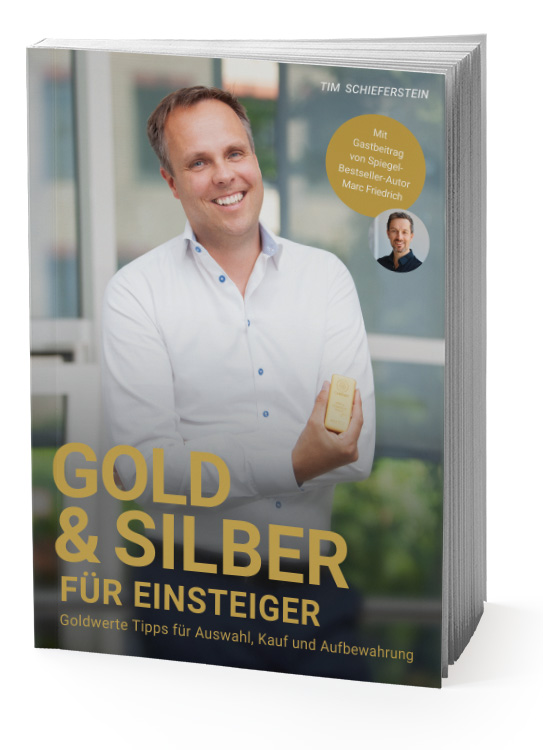Pricing on Gold- Silver Markets - Theoretical Basis
Capital Market Theory versus Behavioral Finance
Capital market theory[1] assumes efficient capital markets due to the large number of market participants, the speed of information dissemination and the fictitious assumption of a rationally acting, utility-maximizing and fully informed homo economicus. It is based on the idea that all price-relevant information is taken into account in the prices traded on the stock exchange - which also include precious metal prices. Therefore, it would not be possible to make profits in the capital markets in the long run using either insider information or fundamental or technical analysis. There should be no long-term cycles, speculative bubbles and successful investors. However, theory abstracts reality, so that there can be deviations between theoretically expected and occurring results, because anomalies and information asymmetries are hidden.[2] The stock market crash in the course of the financial market crisis of 2008/2009, however, underpinned the idea of the efficiency of the markets:[3] Capital market theory and the formation of bubbles are not contradictory, because "theory has never promised to be able to forecast the latter. ... Financial markets are a dynamic, evolutionary system that is efficient on average over the long run, but at times produces quite large deviations from this trend. There is no fundamental contradiction between market efficiency and behavioral finance; rather, the two must complement each other."
Behavioral approaches such as behavioral finance or behavioral economics[4] accept the relevance of market psychology. Accordingly, if market psychological factors are correctly assessed, it is possible to achieve sustainable profits on the stock market, such as through investments in the precious metals sector, because greed and fear move investors to overreact in one direction or another due to the herd instinct. Nevertheless, successful investors like Warren Buffet are rather an exception, because the bulk of fund managers do not manage to outperform the average market performance (which also supports the validity of the capital market theory). For most fund managers, the wisdom established in the cult movie Wall Street by Gordon Gekko (played by Michael Douglas) ultimately holds true: "The stock market is a zero-sum game."
Market Model
Simple market model

The supply function is determined by the marginal cost, i.e., the cost that must be incurred to increase a given quantity of output by one additional unit. Due to the law of diminishing returns growth, it has an increasing trend. Other things being equal, the quantity produced can be changed in the short run by a change in price, and in the longer run by a shift in the curve (e.g., upward due to improved extraction technologies or downward due to rising extraction costs). The percentage change in supply that assumes a one percent change in price is called the price elasticity of supply. The demand function expresses the preferences of demanders. It results from the marginal utility at a given level of demand, i.e., the additional utility when demand is expanded by one more unit. It usually has a decreasing course, i.e. demand decreases as price increases. It can shift, for example, due to changes in inflation expectations, loss of confidence in the currency or changes in preferences. The percentage change in demand for a one percent change in price is the price elasticity of demand, where it has a negative sign.[6]
In market equilibrium, the marginal cost of production exactly equals the marginal benefit of demand. Supply and demand are brought into alignment by the price mechanism, with efficient use of available factors of production and optimal satisfaction of demand. Applied to precious metals markets, the market price is ultimately the equivalent of a market situation in which the level of marginal utility is the same in all uses of precious metals and is equal to the aggregate marginal cost (= price) in each case. Demand will increase in each demand sector - jewelry demand, investment demand, industrial demand, etc. - as long as the incremental utility of the last unit still exceeds the price, so that an increase in demand can still generate a consumer surplus. Actual market activity is, of course, very complex and dynamic. On the one hand, there are time lags, i.e., supply and demand react with a time lag to changing market conditions, and on the other hand, the premises underlying supply and demand developments change continuously. Relatively static market models can therefore only show the interrelationships in a stylized way.
Production and marginal utilization costs
Silver has an intrinsic value, the level of which depends on the abundance of the respective deposits as well as on the amount of labor and capital that had to be expended to extract them.[7] In addition, it has a use value, the level of which depends on the extent to which it can satisfy a specific need.[8] In the long run, precious metal prices will be based on the extraction and marginal use costs.[9] The prices of precious metals will depend on the marginal extraction and use costs
Marginal extraction costs, which are relevant to supply, result from the cost of extracting the last unit of production. They are reduced by new extraction and recycling methods or new precious metal discoveries, and increased by resource depletion and declining mineralization grades. Marginal costs of use determining demand correspond to the foregone profits, discounted to present value, which can no longer be achieved in the future by mining finite resources such as precious metals. Substitution effects have a diminishing effect, while the returning monetary function of precious metals in the light of unstable financial markets, rising inflation expectations and expanding industrial demand have an increasing effect.
The scarcity rent is of central importance: for exhaustible resources, which include precious metals, it indicates the opportunity cost of selling an additional unit of resource. According to the Hotelling rule, the rent for achieving a market equilibrium of resource extraction - the marginal profit - should be at least equal to the market interest rate, since otherwise it would be optimal to extract the resource stock as quickly as possible and invest the profits in higher-yielding assets or projects.[10] The Hotelling rule is also referred to as the main theorem of the economics of exhaustible resources.
Pig cycle and long wave theory
Supply, demand and prices are often subject to periodic fluctuations that follow certain patterns. In economics, this is known as the pig cycle because the causes underlying these market fluctuations were first described for the pig market.[11] The cycle is caused by delayed adjustments in supply; since 15 months elapse between piglet production and the time pigs are ready for slaughter, an increase in the price of pigs does not lead to an increase in supply until about one and a half years later. The increased supply eventually lowers the price, rearing is reduced again, delayed price increases occur again, and a new cycle begins. A theoretical extension is the Cobweb theorem.[12] According to this theorem, delayed adjustments of supply can lead to different, sometimes very pronounced price and quantity reactions depending on the supply and demand elasticities, which is sometimes characteristic for the situation on the precious metals markets.
According to the theory of long waves, economic development proceeds in Kondratieff cycles.[13] According to this theory, economic endogenous factors lead to a regular succession of prosperity and depression phases, such as can be observed on the precious metals markets. They are triggered by fundamental changes as the initiating force of an initially long-lasting upswing, before this turns into a downswing again as a result of the buildup of production capacities and the onset of market saturation. Such cycles sometimes last for decades. Long-term price and volume movements in the precious metals sector occur in cycles, with upward and downward movements lasting 15 to 20 years each, based on experience.[14] Reactivation of closed mines is lengthy and capital-intensive; it can take three to five years, and new construction can take as long as seven years or more.[15]
Book & eBook "Gold & Silver for Beginners" free for you
"An exciting and educational book that will spark interest in investing in precious metals even for people like me who have never looked into this topic before." - Concluded the editor, who subsequently bought gold for the first time.
What are the pros and cons of precious metals? Which bars and coins are recommended and why? What are typical beginner mistakes and how can you recognize a reputable precious metals dealer? Where and how to store precious metals safely? To these and many other questions (not only) beginners will find answers and tips in this approximately 200 pages comprehensive basic reading of precious metals expert Tim Schieferstein on the subject of gold and silver.
With this book we would like to carry out clearing-up work and make so the entrance into a capital investment in precious metals easy. Therefore GoldSilberShop.de gives both the eBook and the printed book to you! Secure your copy today!






